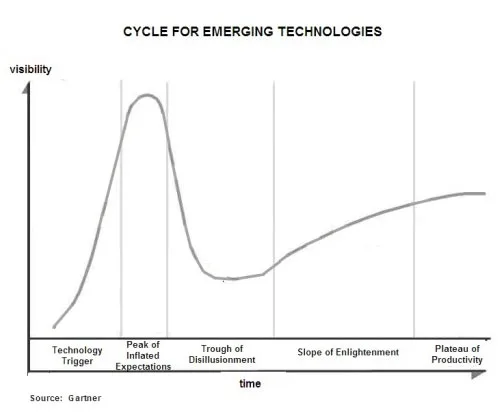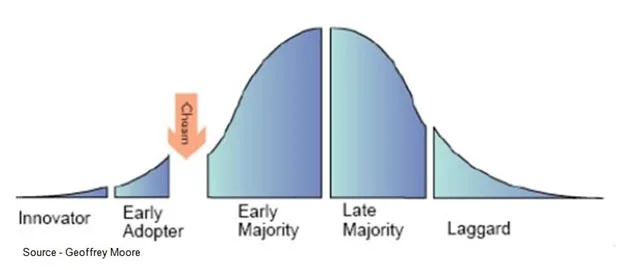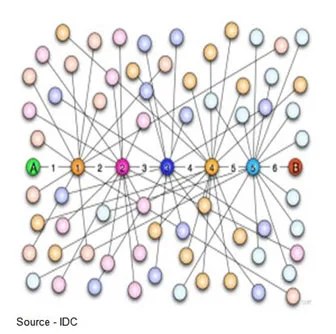Ask, Listen – Consumers Need Time/Help to Jump to Tomorrow

Every day; engineers, programmers, brilliant idea folks– physically and remotely– sit around conference tables around the globe to plan the next insanely great IoT (Internet of Things), IoE (Internet of Everything), smart car, flying thing, smart home or wearable thing.
They’re the “things” everyone is talking about.
They’re the things their competitor recently introduced but they’re certain they can do it better.
They’re certain that in five years, the (fill in the blank) is going to be a $50B market.
The industry rushes insanely great technology/products to market. We get them reviewed/talked about by bleeding-edge media techno-writers and the din of noise fills the media.

Media ranging from print, the web, blogs, radio and TV all cover the insanely great solution.
We forecast fantastic hockey stick sales and insane profits.
Instead of the product category sweeping the globe, it trundles along with so-so to respectable growth … nowhere near the hyped numbers we read.
Obviously, the great technology is a failure.
But as time goes on, the technology slowly — and by now, without the insane profits we envisioned — is absorbed into our daily lives.
It wasn’t magic.
It wasn’t the consumer epiphany.
It comes as a crushing blow to engineers and programmers that consumers don’t really want nor need more technology.
We have enough sound technology available to last us for … awhile.
Technology is important, but even more important is an understanding of the consumer – what he/she really wants – and how to make the technology easy to use and/or seamless to implement/enjoy.
You can make the technology elegantly easy for consumers and you can help them.
Or, you can let them fend for themselves; maybe they’ll figure it out … maybe not.
Easy to Use
Consider Microsoft:
- They rolled out WinXP and over time, it worked pretty well.
- They introduced Win 7 (forget the Vista bump), and over time it worked pretty well.
- They pushed Win 10 (slide over 8, 8.1), and over time it will work pretty well.
Apple’s approach:
- Play your CDs, rip them to mp3, play them on your Mac and BAM! iTunes
- View and share photos on your devices, share them with friends, family–iPhoto
- Cut, paste videos, show them on your device, share with friends–iMovie
- Move your music, photos and videos across all your Apple devices – AirPlay, iCloud
One approach was to throw out newer, better technology.
The other was to deliver a new solution that masks the technology.
Windows was announced in ‘83 – shipped in ‘85 – and every techie was determined to show his/her prowess.
The Mac and its OS hit the streets in ’84 and only appealed to the artsy types … and kids. Technology was hardly mentioned.
Who was superior depended on who you talked with but both were sorta’, kinda’ happy until Apple figured out a communication device is a communications device and well, you know the rest.
There’s a crap load of smartphones out there; but the iPhone reaps the lion’s share of profits.
Kids told other kids and anyone who would listen (WOM – word of mouth) about their awesome iPhone. They brought them to work. The boss wanted one and IT (Information Technology) made it all work.
Data center folks wanted the same type of things they had from “their” vendors – negotiated pricing, custom apps, etc. – but as Storage Bit’s Robin Harris translated their response, “Figure it out or find a new job.”
When kids dragged in their iPads and Macs, the boss thought they might be onto something and figured, “What the heck, we like their phone. Might as well take the dive.”
Suddenly, Apple had become a $25B business IT company and firms were becoming enmeshed in the Apple ecosystem.
But these firms needed special tools to use across their enterprise and rather than build their own (reinvent the wheel), Apple added partners who knew that stuff like IBM and Cisco.
The partners get a piece of the action, Apple saves big bucks and doesn’t dilute its focus.
It’s working well.
But what these corporate customers probably don’t realize is that the cost of moving back to “yesterday’s tools” isn’t worth it for the boss or the up-and-comers.
In fact, we recently read a report that found 21 percent of iOS consumers say they’ll never leave Apple’s ecosystem.
Apple didn’t tout insanely great new technology; they masked it, focusing on being user friendly.
And surprise … people are buying it!

They ignored Geoffrey Moore’s Crossing the Chasm rules – attract the innovators and early adopters and they’ll take care of the consumer masses.
Today, almost every consumer is multichanneled.
They have a dizzying array of resources available to do their own research. They exchange ideas and information freely, unfiltered.
Forrester found that consumers use those resources extensively before they make a buying decision:
- 83% of respondents got their information from friends/acquaintances
- 75% from product/service reviews
- 63% from a known “expert”
- 52% from user reviews on a content site
- 50%from online consumer opinion sites
- 49% from editors on content site
- 37% from online chat rooms, discussion boards, user forums
- 30% from blogger reviews
Word-of-mouth and online reviews/discussions help people move quickly from idle interest to informed purchase.
Customers swap stories about the brands they use, recount their best/worst experiences and discuss how companies compare.
Price is well down the list when it comes to making a decision.
Instead, the emphasis is on the stuff that really counts … service, support, guidance, implementation and assistance.
My wife recently had an issue with our home printer/copier/fax combo and called customer support. A real person answered the phone and the guy stuck with her, helped her until the issue was resolved!
She was amazed. No script, no rote explanation just patient listening and advice.
She told two friends, posted on Facebook and bought one for our son.

She doesn’t realize it but she’s suddenly on the company’s sales staff.
Getting good service/support shouldn’t be such a shock to the system, but it sure seems to be.
Great customer sales support/service should flow naturally but finding people who are knowledgeable and really interested in helping customers is tough.
Constantly reinforcing the act that management really wants them to focus on the customers, not the number of folks handled, is an ongoing process.
Larry O’Connor, founder and CEO of OWC (Other World Computing), said it’s important that team members treat each visitor like the real person they are and understands the importance of their questions.

Whether they come to the company through the online site, over the phone, email or from a retail partner O’Connor emphasized, “When that person leaves, hangs up or disconnects; they know the individual on the other end of the line didn’t use a script but really listened to them. We want to ensure he or she will tell others we’re the kind of people you trust and want to tell their friends about.”
Increasingly, O’Connor is seeing people using the firm’s online tools and not actually talking to a person. He explained the shift by citing a recent Forrester study that found web self-service is now the most widely used communication channel for customer service. This is because consumers want to be in full control of their systems and solutions. No fuss, self-service keeps them in control.
To differentiate themselves from mass merchants, a growing number of customer-focused firms constantly monitor and enhance their online documentation as well as their video how-to and application libraries.
When people prefer or need personal contact/assistance, they can quickly reach a human who knows more than what is in the binder.
The challenge for firms today is to deliver:
- Insanely great, easy-to-use products
- A seamless experience for customers across all platforms and throughout all stages – pre-purchase, purchase and post-purchase
The complete package gets people coming back again and again … telling others along the way.
It’s all part of the complete marketing package – sound product, packaging, documentation, clear understanding of the customer, clear/concise customer-centric information and a commitment to building strong relationships.
 When it’s all working Rick knows why, “Of all the gin joints, in all the towns, in all the world, she walks into mine.”
When it’s all working Rick knows why, “Of all the gin joints, in all the towns, in all the world, she walks into mine.”
And when she comes … she’ll bring friends!
# # #